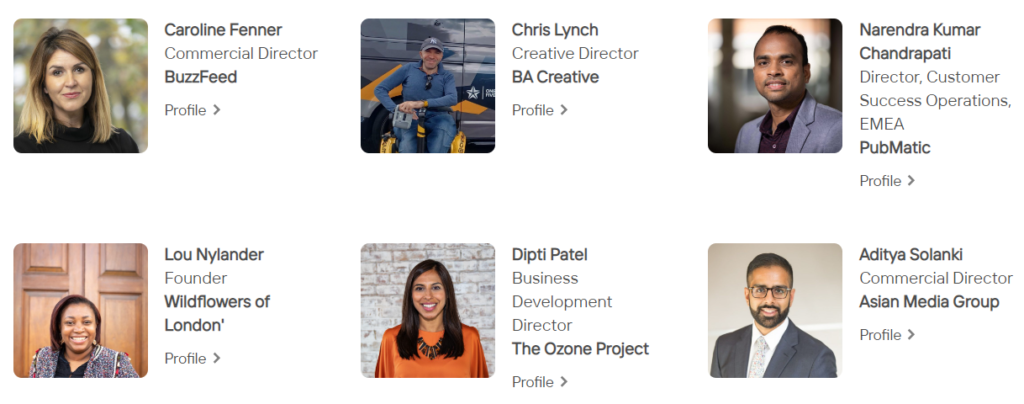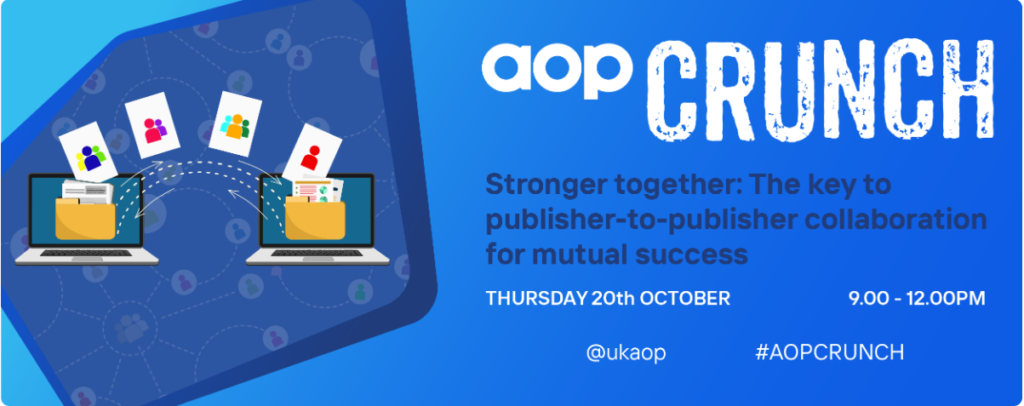|
Getting your Trinity Audio player ready...
|
Editor’s note: This feature by Richard Reeves, Managing Director, Association of Online Publishers (AOP) corroborates our recent visit to the World News Media Congress in Zaragoza where a number of Spanish publishers were seeing significant success by collaborating rather than competing, even when serving the same audiences.
For AOP’s final CRUNCH event of the year, experts from across the digital publishing world discussed how collaboration can diversify revenues, promote audience extension, and ensure underrepresented communities get a place at the table.
Lou Nylander, Founder of Wildflowers of London, spoke with leading voices from various publishers, agencies, and platforms about how working together can uplift both big and small players and help the industry solve its most pressing challenges.
Lessons on supply chain pruning from Asian Media Group’s partnership with Ozone
Getting a fair share of online revenue has proven difficult for Asian Media Group. The family-run publisher has its heritage in print media, led by flagship newspapers, Garavi Gujarat, a household name for Gujarati natives, and Eastern Eye, a weekly English language newspaper for the British Asian community. But digital publishing demanded an entirely different commercial approach, tech stack, and set of skills – a challenge for a smaller publisher with limited resources. Direct client relationships bolstered its B2B digital advertising deals, but the open marketplace of its B2C sites was not providing revenue equal to the effort being put into its content.
This difficulty in extracting a fair value exchange from the programmatic ecosystem led Asian Media Group to Ozone, which helps premium publishers of any scale connect with premium advertisers by optimizing their web design, technology, and supply paths. This gave Aditya K Solanki, Asian Media Group’s Director of Digital Media, access to insights and resources typically reserved for the industry’s biggest players or digitally-native brands.
Solanki detailed the new quality-over-quantity approach that resulted from the partnership: “Previously, we understood the more ad spaces you have, the more revenue you’re going to get. That’s the simple logic most publishers would follow. Some small advice from Ozone would be to reduce how many ads you have. Just focus on premium ad spaces, you don’t need to bombard pages with hundreds of adverts.
“Also understanding that you should sell your content at a premium, there’s no point having 15, 20, 30 SSPs linked because you’re diminishing your returns.”
It’s better to work with one or two premium partners, making sure we get the premium value for the content we’re going to be generating. We heavily invest in journalism, all publishers do, and it’s nice to get that reward in terms of revenue that’s deserved.
Aditya K Solanki, Asian Media Group’s Director of Digital Media

For Dipti Patel, Business Development Director at Ozone, there is not a sustainable future for journalism on the open web unless premium publishers join forces: “Publisher collaboration has never been so important … We need to get that money flowing into our environments and we need to increase dwell time, increase engagement, and show that premium environments have results that are just as good as the walled gardens.
“The deprecation of third-party cookies is imminent, and this is where publishers need to get back into the driving seat to really own their first-party data strategies. Publishers need to be thinking about working with partners who are going to help them regain that data, help them regain control of their inventory … Publishers need to challenge ad tech, challenge their partners …”
The power dynamic over the last ten years where ad tech has had significant control over the publisher relationship absolutely needs to change, that has to flip.
Dipti Patel, Business Development Director, Ozone
Brand Advance shares how authentic content and diverse collaborations support underrepresented communities
The Brand Advance Group — which includes a creative agency, an SSP, a media agency, and more — partners with 1,000+ minority-owned publications across 32 countries to connect them with brands that want to reach out to the communities they represent. As a result, it helps send premium revenue flowing to diverse voices outside the mainstream of digital journalism. Brand Advance also publishes its own content, such as its new Included magazine, a passion project for Chris Lynch, Creative Director.
For Lynch, Included is an opportunity to provide inspiring content for the 20% of the population who live with a disability, and for that inspiring content to be for them rather than about them: “There’s this term that’s used within the disabled community: ‘inspiration porn.’ This refers to the way that able-bodied individuals will automatically classify someone with a disability as being “inspirational”. But [Included’s content] is more about the people at the top of the tree within the disabled community, inspiring others to develop their careers and their lives.”
Such authenticity can only be achieved when content is created by people from within the communities they are representing. Lynch urged those who want to collaborate with diverse publications to do their due diligence; to check their content creators and wider staff are as representative as they claim, to ensure revenues and opportunities are reaching the intended communities.
Chris Kenna, CEO of Brand Advance, wants to see big brands use their platform to direct their audiences towards a diverse network of publications, and pointed to content recommendation tools, such as those offered by Outbrain, as a simple way to achieve this:
“If you’re reading an article in The Guardian about Black History Month, there’s no reason why you can’t bring in a few headlines from Black-owned publishers to that article so that somebody can continue that reading journey. It’s doing two good things: one, it’s giving The Guardian more Black-written content without having to hire a single person; and then two, it’s giving the readers more options as well.
“That’s true collaboration… It’s not going to stop people reading The Guardian, but it is going to grow these publishers so they can get more revenue and employ more people.”
To be quite honest… if we’re going to stick black boxes on our socials and say we stand shoulder to shoulder, there needs to be true collaboration.
Chris Kenna, CEO of Brand Advance

Are the walled gardens friend or foe for premium publishers?
Narendra Kumar Chandrapati, Director of Customer Success Operations at PubMatic EMEA, sees the deprecation of third-party cookies on Chrome as an opportunity for publishers to come together for audience extension and enrichment, as well as collaborating with media buyers and agencies to realize more revenue from their first-party data. Without breaking down walls between publishers and the wider open ecosystem, Chandrapati warned that the industry will cede more control to the walled gardens that already take up the lion’s share of ad spend.
“This is the right time for us to come together as a group,” said Chandrapati. “Publishers have a rich amount of first-party data, but that alone is not sufficient for most of the media buyers. We need to enrich it with viewability, or contextual targeting, or zero-party data added on top of first-party data.”
These are some things that publishers can work together and learn from each other. This definitely helps us as an industry going forward together and not being dependent on the walled gardens … keeping us on our toes.
Narendra Kumar Chandrapati, Director of Customer Success Operations at PubMatic EMEA
But not all publishers have an antagonistic relationship with the walled gardens. For BuzzFeed Inc, such platforms have been key to connecting with the Gen-Z and millennial audiences that their brands cater to. Caroline Fenner, BuzzFeed’s Commercial Director, maintains strong relationships with Google, Meta, and Amazon as distribution partners for editorial, advertising, and branded content. Without them, said Fenner, BuzzFeed probably wouldn’t exist.
BuzzFeed also invests heavily in the rapidly rising ecosystem of independent content creators that have evolved from the influencer market. Such talent has proven crucial in connecting with younger audiences, and the line between journalist and content creator has blurred as publications expand to new platforms. BuzzFeed has doubled down on TikTok despite measurement and monetization still being a work in progress for the access it gives them to the new generation of online talent who, despite their independence, still have much to gain from collaborating with a major publisher.
“It’s the burnout individual creators get that [we can help with] … We provide a wage, production, brand opportunities, and monetization. [Creators might think,] ‘Oh, why do we need BuzzFeed, because we can do this ourselves?’ But actually, it’s such a crowded space that what we can do is bring people up. What we’re not scared of saying is, ‘Off you go now, you’re big enough.’ So we’re happy to keep developing and bringing in new talent which is unique and new.”
Whether a publisher wants to work within or outside of the walled gardens, what is clear is that no publisher is an island. From supporting diverse voices and tapping into fresh talent, to sharing audiences across titles and unlocking new revenue streams, publishers have far more to gain by collaborating with one another and with the brands that recognize the value of premium content.
Richard Reeves
Managing Director, AOP



